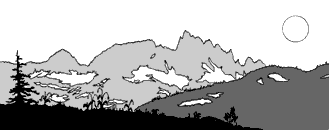End of Season Ranger Reports
These end-of-season reports were written by rangers stationed at backcountry ranger stations in Sequoia & Kings Canyon National Parks. The reports span the years 1983 to 2015, although reports are missing for some years and for some stations.
In these reports, rangers document wilderness issues that also concern the High Sierra Hikers Association, such as:
- Damage to meadows and trails, and pollution of meadows, water sources, and campsites by stock animals.
- Appropriate hiker and stock party sizes.
- Water-borne diseases and invasive weeds introduced by stock animals.
- The appropriate elevation for allowing fires.
- Low flying military jets.
Recurring problems found in the Ranger Reports
The High Sierra Hikers Association has compiled excerpts from the ranger reports to highlight the following recurring problems encountered by rangers.
| Commercial Stock Use | A record of failed policies and environmental degradation |
| Dead Stock | Stock animals that made the ultimate one-way trip |
View and Search Ranger Reports
Ranger Reports sorted by station
Search ranger reports:
About These Ranger Reports
Backcountry ranger stations are typically located on major trails, and are staffed during the peak visitor season of late May/early June until shortly after Labor Day. Rangers patrol the area around their stations, answer visitors' questions, assist with illnesses and injuries, and enforce park regulations. The rangers write the reports published here at the end of their work season. The reports are written for the rangers' supervisors to aid in future planning.
Most of the typewritten ranger reports are searchable. To search through all of the reports, use the search box on this page. To search in a single report, locate the report, click the report to open it, and then search. The handwritten reports are not searchable.
If you have difficulty opening these reports, you can try to install the free Adobe Acrobat Reader on your computer. Alternatively, you can try a different web browser such as Google Chrome or Mozilla Firefox.
File naming scheme for 1983 to 2003 ranger reports
Ranger reports for the years 1983 to 2003 are in separate PDF files for each year and ranger station. The file names (such as 1986CharlotteDurkee.pdf) have three parts:
| Year | The year for which the report was written, like 1986. |
| Ranger station | A shortened form of the ranger stations, such as Charlotte for Charlotte Lake. |
| Author | The last name of the ranger who wrote the report, such as Durkee for George Durkee. In a few cases, the ranger is unknown. |
Combined yearly ranger reports for 2004-2015 with redactions
For the years 2004-2015, reports for all ranger stations are combined into one PDF file per year. This set of ranger reports has redacted information, which means certain words and graphics are blacked out. The Park Service has redacted information for a variety of reasons, including protecting people's privacy, hiding the location of sensitive historical sites, etc. The Park Service has provided the HSHA with a "Vaughn Index" file which lists the reasons that each specific section has been redacted.
